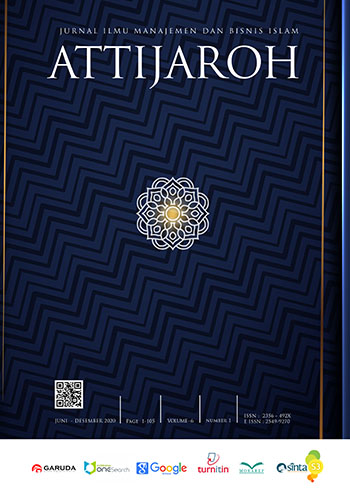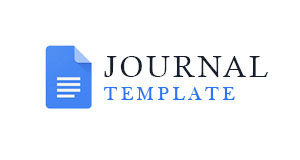Murabahah: A Strategic Solution For Credit Risk Mitigation In Islamic Banking
Abstract
Keywords
Full Text:
PDFReferences
Akram, H., & Rahman, K. u. (2018). Credit Risk Management. Isra International Journal of Islamic Finance, 10(2), 185–205. https://doi.org/10.1108/ijif-09-2017-0030
Ala’raj, M., Abbod, M. F., & Radi, M. (2018). The Applicability of Credit Scoring Models in Emerging Economies: An Evidence From Jordan. International Journal of Islamic and Middle Eastern Finance and Management, 11(4), 608–630. https://doi.org/10.1108/imefm-02-2017-0048
Alam, A., Sukmana, R., Fianto, B. A., & Izzuddin, A. (2022). Comparative Analysis of Murabahah and Mudharabah Financing Risk From Islamic Microfinance Institutions Perspective. Al-Muzara Ah, 10(1), 79–92. https://doi.org/10.29244/jam.10.1.79-92
Alhammadi, M. A. A. (2024). Credit Scoring and Risk Management in Islamic Banking: The Case of Al Etihad Credit Bureau. Revista Venezolana De Gerencia, 29(105), 111–124. https://doi.org/10.52080/rvgluz.29.105.8
Alhammadi, S. (2022). Analyzing the Role of Islamic Finance in Kuwait Regarding Sustainable Economic Development in COVID-19 Era. Sustainability, 14(2), 701. https://doi.org/10.3390/su14020701
Anagnostopoulos, Y., & Abedi, M. (2016). Risk Pricing in Emerging Economies. International Journal of Finance & Banking Studies (2147-4486), 5(1), 51–72. https://doi.org/10.20525/ijfbs.v5i1.41
Arif, M., & Rahmawati, Y. (2018). Determinant Factors of Market Share: Evidence From the Indonesian Islamic Banking Industry. Problems and Perspectives in Management, 16(1), 392–398. https://doi.org/10.21511/ppm.16(1).2018.37
Berniz, Y. M., Najmudin, N., Jayanti, E., Rahmawati, I. Y., & Utami, Y. (2023). The Influence of Third-Party Funds; Asset Quality, Profit, and Lost Sharing to the Islamic Bank Liquidity in Indonesia. International Journal of Science Technology & Management, 4(4), 1023–1033. https://doi.org/10.46729/ijstm.v4i4.876
Corso, D. (2021). Drawbacks and Aftermath of the Affordable Care Act: Ex-Ante Moral Hazard and Inequalities in Health Care Access. Journal of Public Health Research, 10(4). https://doi.org/10.4081/jphr.2021.2135
Darwish, P. S. (2015). Strategies to Shape the Future of Islamic Financial Risk Management and Takaful Insurance. Journal of Islamic Banking and Finance, 3(1). https://doi.org/10.15640/jibf.v3n1a6
Faisal, F., Maulana, R., Sulaiman, S., & Kunarti, S. (2023). Taking Over Consumptive Loans Without Collateral: (Research Study on Bank Syariah Mandiri Lhokseumawe). Jurnal Dinamika Hukum, 23(1), 161. https://doi.org/10.20884/1.jdh.2023.23.1.3392
Fajarini, D. (2023). Blanket Guarantee for Stabilization or Moral Hazard? Study Cases: Conventional Bank in Indonesia. https://doi.org/10.4108/eai.13-9-2023.2341214
Ferhi, A. (2018). Credit Risk and Banking Stability: A Comparative Study Between Islamic and Conventional Banks. International Journal of Law and Management, 60(4), 1009–1019. https://doi.org/10.1108/ijlma-05-2017-0112
Gilani, H. (2015). Exploring the Ethical Aspects of Islamic Banking. International Journal of Islamic and Middle Eastern Finance and Management, 8(1), 85–98. https://doi.org/10.1108/imefm-09-2012-0087
Hachem, B., & Sujud, H. (2018). Islamic Versus Conventional Banks in Lebanon: An Empirical Study of Credit Risk Management. International Journal of Economics and Finance, 10(8), 53. https://doi.org/10.5539/ijef.v10n8p53
Hambali, A., & Adhariani, D. (2022). Sustainability Performance at Stake During COVID-19 Pandemic? Evidence From Sharia-Compliant Companies in Emerging Markets. Journal of Islamic Accounting and Business Research, 14(1), 80–99. https://doi.org/10.1108/jiabr-01-2022-0014
Hamid, M. A., & Janor, H. (2018). Determinants of Credit Risk in Islamic and Conventional Bank: Evidence From Malaysia. International Journal of Academic Research in Business and Social Sciences, 8(6). https://doi.org/10.6007/ijarbss/v8-i6/4301
Hanifa, R. (2024). The Influence of the Marketing Mix on the Interests of Customers Using Murabahah’s Financing Products. Islamic Banking Jurnal Pemikiran Dan Pengembangan Perbankan Syariah, 9(2), 329–350. https://doi.org/10.36908/isbank.v9i2.1064
Iman, A. N., Wardhana, A. K., Rusgianto, S., & Ratnasari, R. T. (2022). Venture vs Investment, Which Type of Financing Was More Demanded by Agriculture, Forestry, and Aquaculture Sector? Daengku Journal of Humanities and Social Sciences Innovation, 2(5), 587–595. https://doi.org/10.35877/454ri.daengku1116
Isamail, M. Z. (2023). The Role of Asset-Liability Management on Financial Stability in Malaysia. International Journal of Academic Research in Business and Social Sciences, 13(5). https://doi.org/10.6007/ijarbss/v13-i5/17257
Japalsyah, M. A., & Hakim, M. Z. (2021). Factors Affecting Mudharabah Financing in Islamic Banks in Indonesia. At-Tijaroh: Jurnal Ilmu Manajemen Dan Bisnis Islam, 7(2), 230–243. https://doi.org/10.24952/tijaroh.v7i2.4363
Jedidia, K. B. (2020). Profit- And Loss-Sharing Impact on Islamic Bank Liquidity in GCC Countries. Journal of Islamic Accounting and Business Research, 11(10), 1791–1806. https://doi.org/10.1108/jiabr-10-2018-0157
Kasim, N., Htay, S. N. N., & Salman, S. A. (2016). Empowering the Shari’ah Committee Towards Strengthening Shari’ah Governance Practices in Islamic Financial Institutions. Review of European Studies, 8(2), 142. https://doi.org/10.5539/res.v8n2p142
Mansoor, M., Ellahi, N., Hassan, A., Malik, Q. A., Waheed, A., & Ullah, N. (2020). Corporate Governance, Shariah Governance, and Credit Rating: A Cross-Country Analysis From Asian Islamic Banks. Journal of Open Innovation Technology Market and Complexity, 6(4), 170. https://doi.org/10.3390/joitmc6040170
Meslier, C., Risfandy, T., & Tarazi, A. (2017). Dual Market Competition and Deposit Rate Setting in Islamic and Conventional Banks. Economic Modelling, 63, 318–333. https://doi.org/10.1016/j.econmod.2017.02.013
Miah, M. D., & Sharmeen, K. (2015). Relationship Between Capital, Risk and Efficiency. International Journal of Islamic and Middle Eastern Finance and Management, 8(2), 203–221. https://doi.org/10.1108/imefm-03-2014-0027
Moertiono, R. J., Syahbudi, M., & Siregar, S. (2021). Implementation of Good Governance Business Sharia (Ggbs) in Islamic Banking in Indonesia. At-Tijaroh: Jurnal Ilmu Manajemen Dan Bisnis Islam, 7(2), 158–176. https://doi.org/10.24952/tijaroh.v7i2.3355
Mohomed, M. R. N. (2016). Islamic Credit Union: An Inclusive Financial Institution to Meet the Needs of the Community. Comsats Journal of Islamic Finance, 1, 57–72. https://doi.org/10.26652/cjif.120166
Mukit, M. M. H., Muneeza, A., & Paltrinieri, A. (2021). Contributions of Professor M. Kabir Hassan to the Islamic Finance Literature: A Bibliometric Study. Jurnal Ekonomi Malaysia, 55(3), 49–76. https://doi.org/10.17576/JEM-2021-5503-04
Nadina, A., Mubarok, F. K., & Haryati, Y. (2022). Analysis of Financing Risk Management Implementation at Baitul Maal Wat Tamwil. Al-Arbah Journal of Islamic Finance and Banking, 4(1), 51–62. https://doi.org/10.21580/al-arbah.2022.4.1.14664
Nawi, N. C., Mamun, A. A., Nasir, N. A. M., Abdullah, A., & Mustapha, W. N. W. (2019). Brand Image and Consumer Satisfaction Towards Islamic Travel Packages. Asia Pacific Journal of Innovation and Entrepreneurship, 13(2), 188–202. https://doi.org/10.1108/apjie-02-2019-0007
Njoroge, J., & Ngahu, S. (2017). Influence of Risk Management Practices on Credit Performance in Islamic Banking at First Community Bank in Nairobi, Kenya. Iosr Journal of Humanities and Social Science, 22(5), 41–46. https://doi.org/10.9790/0837-2205104146
Norrahman, R. A. (2023). Murabaha Contract Dispute Resolution Procedure. Sharia Oikonomia Law Journal, 1(4), 241–254. https://doi.org/10.55849/solj.v1i4.584
Nugroho, L., Badawi, A., Nugraha, E., & Putra, Y. M. (2021). What Determines Islamic Performance Ratio of Islamic Banking in Indonesia? An Analysis Using Financing to Deposit Ratio as Moderator. Share Jurnal Ekonomi Dan Keuangan Islam, 10(1), 104. https://doi.org/10.22373/share.v10i1.9314
Nurhidayat, Y. (2018). An Application of Generalized Moments Method to Examine the Management Behavior During Peak Season a Study in Islamic Micro Finance Industry. Matec Web of Conferences, 218, 4025. https://doi.org/10.1051/matecconf/201821804025
Pappas, V., Ongena, S., Izzeldin, M., & Fuertes, A.-M. (2016). A Survival Analysis of Islamic and Conventional Banks. Journal of Financial Services Research, 51(2), 221–256. https://doi.org/10.1007/s10693-016-0239-0
Prasetyo, K. A. V. (2024). Analysis of Factors in the Interest of KSPPS Binama Members in Choosing Murabahah Agreement Financing. Transekonomika Akuntansi Bisnis Dan Keuangan, 4(1), 57–66. https://doi.org/10.55047/transekonomika.v4i1.536
Serwadda, I. (2018). Impact of Credit Risk Management Systems on the Financial Performance of Commercial Banks in Uganda. Acta Universitatis Agriculturae Et Silviculturae Mendelianae Brunensis, 66(6), 1627–1635. https://doi.org/10.11118/actaun201866061627
Syamlan, Y. T., & Jannah, W. (2019). The Determinant of Credit Risk in Indonesian Islamic Commercial Banks. Share Jurnal Ekonomi Dan Keuangan Islam, 8(2), 181. https://doi.org/10.22373/share.v8i2.5051
Tabash, M. I. (2018). An Empirical Investigation Between Liquidity and Key Financial Ratios of Islamic Banks of United Arab Emirates (UAE). Business and Economic Horizons, 14(3), 713–724. https://doi.org/10.15208/beh.2018.50
Utami, S. A., Cakyaneu, A., & Wulandari, N. S. (2020). Analysis of Home Ownership Financing for Islamic Banks in Indonesia Through Sharia Asset Backed Securities-Participation Letter. Amwaluna Jurnal Ekonomi Dan Keuangan Syariah, 4(2). https://doi.org/10.29313/amwaluna.v4i2.5404
Zamroni, M. A. (2023). Implementation of Murabahah in Sharia Banks According to the Al-Qur’an Surah Al-Baqarah Verse 275. DRS, 1(2), 57–67. https://doi.org/10.59373/drs.v1i2.5
DOI: https://doi.org/10.24952/tijaroh.v10i2.14459
Refbacks
- There are currently no refbacks.
Copyright (c) 2025 At-tijaroh: Jurnal Ilmu Manajemen dan Bisnis Islam

This work is licensed under a Creative Commons Attribution-ShareAlike 4.0 International License.








